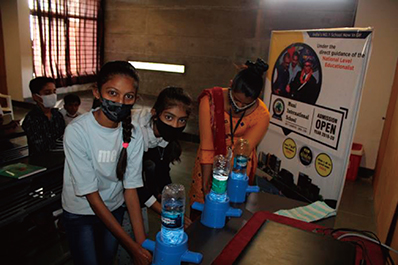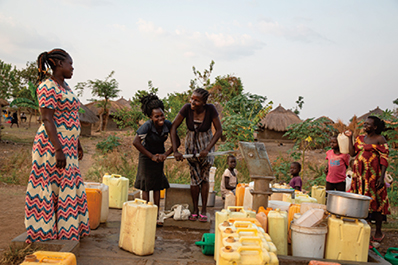(2) Water and Sanitation

The “Achhi Aadat (Good Habit in Hindu)” Campaign, a hygiene awareness campaign that includes hand washing, was implemented in Uttar Pradesh State, India. Children washing their hands with products that can be used to effectively prevent infections even in households without water supply or other hand-washing facilities. (Photo: JICA)
Water and sanitation are vital issues linked to human life. Throughout the world, approximately 2.2 billion people are not provided with safely-managed drinking water, and 4.2 billion people cannot use safely-managed sanitary facilities such as toilets. Moreover, in developing countries where piped water is not widely available, women and children sometimes spend many hours fetching water, which deprives children of opportunities for education and women of engaging in society. Furthermore, an unstable supply of water has a negative impact on healthcare and agriculture. SDG 6 sets forth the target “Ensure availability and sustainable management of water and sanitation for all.”
● Japan’s Efforts

Refugees from South Sudan drawing water at a water supply facility in a refugee settlement in northern Uganda. They also take the initiative to improve water supply services in the settlements (Photo: UNHCR) (see also “Stories from the Field”).
Japan has the top cumulative track record in the world in the fields of water and sanitation support since the 1990s.
In 2021, Japan implemented projects for the development and expansion of piped water in Cambodia, Indonesia, Laos, Viet Nam, and other countries. For example, Japan provides Grant Aid to internally displaced persons and surrounding communities in conflict-affected ethnic minority areas in Rakhine, Kachin, and the northern Shan states of Myanmar in cooperation with UNICEF. It aims to improve health environments, ensure access to safe water, improve hygiene and sanitation, and improve learning environments. In addition, in Malawi, Japan implements a technical cooperation project to strengthen the capacity of the Lilongwe Water Board to improve water use efficiency. The Yokohama Waterworks Bureau provides cooperation, and Yokohama’s expertise in water supply operations are utilized to solve Malawi’s water problems (see “Master Techniques from Japan to the World 2” for details).
Efforts for the improvement of the water environments in developing countries in cooperation with Japanese and local private companies and organizations are also being made around the world. For example, in Indonesia in Southeast Asia, a verification survey with the private sector for disseminating Japanese technologies for automatic regenerating activated carbon wastewater purification systems was implemented with a view to promoting the use of regenerated water and industrial wastewater treatment, utilizing JICA’s SDGs Business Supporting Surveys. The project is expected to solve environmental problems such as river pollution caused by insufficient treatment of dye effluent and ground subsidence following excessive ground water intake in the country, where the textile industry thrives. The project has produced positive results, including the sale of two large-scale purification systems in the country.
In order to overcome the lack of local information and knowledge with regard to the problem of serious water contamination in many Asian countries, the Ministry of the Environment (MOE) implements the Water Environment Partnership in Asia (WEPA). With the cooperation of the 13 participating countries Note 49 from Asia, WEPA aims to enhance water environment governance in Asia through building human networks, gathering and sharing information, and capacity building. In March 2021, the 16th WEPA Annual Meeting was held online. It focused on the “Current Status and Challenges of Domestic Wastewater Treatment,” and the participants shared information on progress made on water environment governance in each country and engaged in an active exchange of views. Moreover, to contribute to achieving “halving the proportion of untreated wastewater” that is raised in Target 6.3 of the SDGs, Japan introduces its advanced septic tank technology, legislative systems, etc., mainly for Asian regions. The 8th and 9th workshops were respectively held online in January and November 2021. During the workshops, presentations and active discussions were held on themes related to the decentralized wastewater treatment system “Johkasou” against water-borne disease and natural disasters, as well as common issues of decentralized wastewater treatment systems such as cleaning up, transportation, treatment and disposal of sludge. Japan co-hosted webinars in Laos in February 2021, and in Sri Lanka and Cambodia in March, with the respective local governments to implement proposal activities for both physical and non-physical aspects of septic tanks and to promote the spread of septic tanks in developing countries.
- Note 49: The 13 countries are Cambodia, China, Indonesia, Republic of Korea, Laos, Malaysia, Myanmar, Nepal, the Philippines, Sri Lanka, Thailand, Viet Nam, and Japan.
